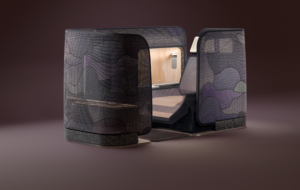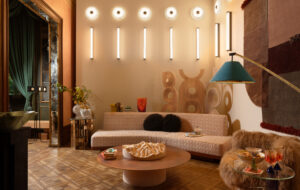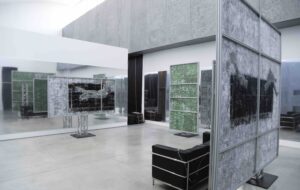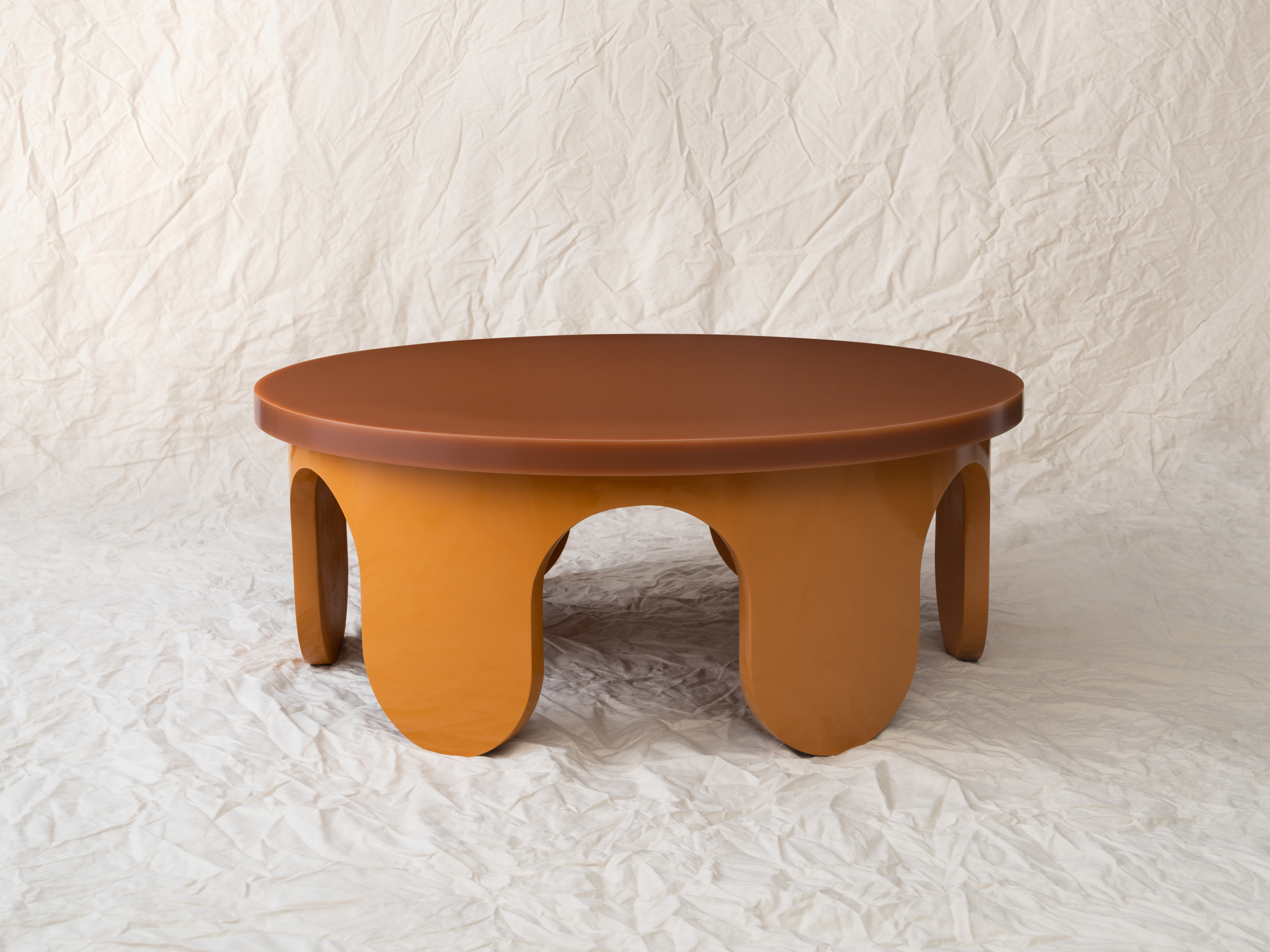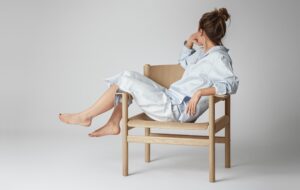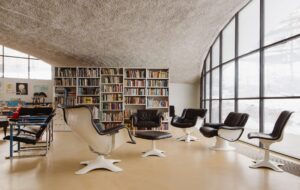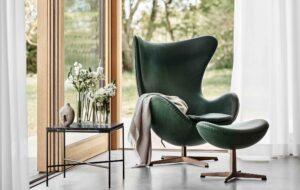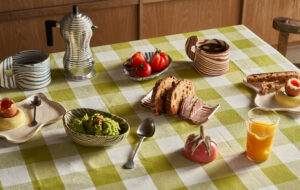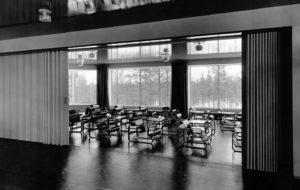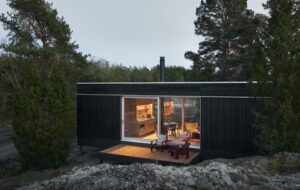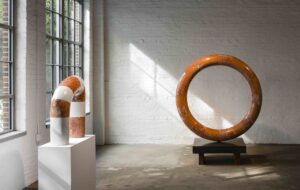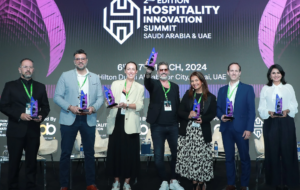



words Lesley Jackson
“When I’m working in textiles or ceramics, people never ask whether the work has a female touch,” says Hella Jongerius. “But when I’m designing furniture, they suddenly start asking, ‘Do you think this is a woman’s approach?’”
I’m halfway through my interview with the Dutch designer and the conversation has worked its way round – with a certain inevitability – to the issue of gender. So how does she feel about being one of the most high-profile female designers in the world? “That’s very simple!” she cries, clutching her breasts. Yes, she is a woman, she seems to be saying, but that’s irrelevant to how her work should be perceived.
And with that, we move swiftly on. It is mid April and Jongerius has just returned to Rotterdam from a triumphant week at Milan. Her latest ceramics for Dutch manufacturer Royal Tichelaar Makkum – a colourful collection of hand-painted majolica called Non Temporary – were well received at the city’s furniture fair. But also garnering accolades was the prototype for Polder, her new sofa for Vitra – a super-sized piece with multicoloured mix-and-match cushions, vintage buttons and tasselled studs. And besides this first commission for the elite furniture brand, she is also launching a range of products for Ikea.
“This was a nice scale change for us,” she says of the Vitra sofa. “I’ve waited a long time to work on furniture. With tableware, it’s so small you can put a lot of information on it, but with furniture you have to be more silent. I used to think, whoa, no more furniture! But we’re happy to be in the Vitra group because it’s the best. We’re not married yet, but we’re dating, so to speak.”
Milan is one of the few events in the design calendar at which you’re likely to spot Jongerius. She’s a private person and not one to court publicity – she confesses (unapologetically) that she doesn’t normally read design magazines. She is regarded by many in the design world as the world’s greatest living female designer but her refusal to engage with the design circus means she’s relatively unknown outside the cognoscenti.
“Hella is among the most interesting and innovative product designers working today,”
says Alice Rawsthorn, director of the Design Museum in London, which honoured Jongerius with a prestigious solo show two years ago. “One of the most important themes in contemporary design is to imbue industrially produced objects with the character that people have traditionally loved in hand-crafted pieces, and Hella is at the forefront,” she says.
“When you see Hella’s work for the first time, it looks odd and ungainly. You just don’t get it. But once you start using it, you realise how sensitive and intelligent it is.”
Having agreed to a face-to-face interview, Jongerius gives me her full attention – that is, if you discount the surreptitious crocheting while we chat. Making things by hand is an addiction. “I’m always complaining that I’m stuck behind my laptop, when I’d rather be cutting and knitting. It’s very difficult because clients always want to see me and journalists want to see me. So it’s very hard to get my hands dirty, but I fight!”
Hella Jongerius might be one of the hottest designers working today, but she’s not remotely intimidating – on fact, she’s refreshingly down to earth. As soon as I arrive, she makes me a cup of coffee, rather than summoning a minion to do it. “I’m so Dutch,” she admits, explaining the moral dimension in her character: half establishment preacher, half radical dissenter.
Jongerius is wryly self-deprecating, but has an underlying confidence in her own abilities, and feels no urge to trumpet her creative achievements. “I’m not the biggest designer in the world,” she declares. “My talent is that my intuition is very good. If I see ten things on a table, I know this is something and this is nothing. Also, with people and companies, in a split second I know what I want and what decision to take.” She views the media as a distraction and is critical of its superficiality. “It’s all hot air. It’s really nothing,” she says dismissively. She’s especially wary of the damaging impact of the early over-exposure on emerging graduates. “Now you have a whole group of students who don’t come to be a designer, but come to be famous.”
Her own reputation has grown steadily since graduating from Design Academy Eindhoven in 1993, initially through her alliance with Droog, latterly through the work of JongeriusLab, established in 2000. “For me, Droog was a very good step for starting a career,” she says. “At the beginning we really did something new.” But she makes it clear that the links are now severed. “I wanted to do it on my own, and they went on doing it their way.”
At JongeriusLab she works closely with Arian Brekveld, her senior designer and “right hand” for the last eight years. “Everything that goes out of the studio, we’ve both decided that this is it. We do it together,” she acknowledges. Jongerius generates the initial concepts, but relies on Brekveld as her sounding board and chief collaborator. Apart from him, there are just three others in the studio – Iris Toonen, who makes all the samples; Edith Van Berkel, who specialises in decoration; and Olga Kostanje, “the captain of the ship”, who deals with press and exhibitions. “I’m not a people manager,” Jongerius confesses. “The studio is small so that I can still design. These days I only take nice-sized projects, and I only do the ones that I really like.”
There’s a relaxed and friendly atmosphere in the office – a palatial old building on Eendrachtsweg, right in the centre of Rotterdam, all dark wood panelling, imposing doors and colourful stained glass, with a pretty garden at the back. A remarkably civilised environment for such a notoriously avant-garde designer you might think, but not uncommon in Holland apparently, where decaying historic buildings (this one is subsiding, hence unsaleable) are made available rent-free to artists and designers by the government.
Jongerius’s early designs were usually ones she came up with herself and mainly restricted to one-offs, limited editions or batch production. When she finally convinced Makkum to put her flaws-and-all B Set porcelain dinner service into production, it marked a significant breakthrough. “This range was all about showing the process and enjoying the imperfections. It was a real bombshell in the ceramics industry to make pieces that were a bit out of shape.”
Capitalising on her growing fame, Jongerius has now made a conscious decision to collaborate with larger manufacturers. All her recent projects for the last couple of years have been for outside clients. “I want to explore whether my ideas will stay alive
if I’m designing for a larger market. Maybe people will be disappointed, or maybe I’ll have to accept that I can’t change the world but, for now, that’s what’s triggering me.”
The idea of Jongerius hitting the high street is an intriguing prospect, but is she in danger of diluting her uncompromising design ethos? “If you decide to start working for companies, you have to accept that you can’t be as radical as if you’re doing self-initiated work, because it’s about money and getting inside the company – thinking what is their vision. Otherwise, don’t do it,” she concludes bluntly. Her aim is to take advantage of her status in order to infiltrate and influence the mainstream – the designer as Trojan Horse.
Until recently, Jongerius was regarded as a maverick, someone who preferred to work independently and do her own offbeat thing. But her partnership with the New York-based textile company Maharam, ongoing since 2002, has changed all that, demonstrating that her avant-garde concepts have sound commercial applications. Using compilations of motifs from Maharam’s archives, Jongerius has created a series of woven upholstery fabrics called Repeat Classic. The patterns are huge, with three-metre repeats, and often incorporate extraneous technical information, such as hand-written pattern codes, into the design.
Wrong-footing of this kind is typical of Hella Jongerius’s design strategy, making us think there’s been a mistake. She woos us with the reassuringly familiar, then unnerves us by introducing alien elements or shifting perspective. In her hands, design becomes a form of industrial sabotage. “Cultural correctness is something that I hate,” she says emphatically. “It’s a bit like, ‘fuck it!’” is how she characterises her subversive spanner-in-the-works philosophy. (The expletive is spoken in a whisper.) Ironically, perhaps, this formula works particularly well with the most traditional manufacturers, partly because the shock factor is increased, but also because the older the company, the richer its history and the larger its archives. Jongerius delights in digging out old shapes or patterns, detaching them from their original context and messing around with them.
For German porcelain manufacturer Nymphenburg she has created a series of luxurious, but subtly seditious, bowls and plates called Nymphenburg Sketches. The bowls have animal figurines marooned surreally in the centre, and are spectacular examples of high-end kitsch, draped in opulent patterns spilling on to the base. The plates are adorned with exquisite hand-painted motifs, such as flowers and butterflies, cherry-picked from the company’s historic pattern books. These images are juxtaposed with workaday markings, such as factory stamps and colour trials, which draw attention to the hidden processes behind Nymphenburg’s otherwise immaculate products.
This August sees the launch of Jongerius’s first venture into the global mass market – four vases for Ikea’s PS range. “Initially I was afraid to take the job with Ikea,” she admits, “but I decided to work in ceramics because it’s a field I know. So I thought I’d design some vases, nothing special, but I’d like to see if it’s possible to keep my handwriting, my style, my grammar, if they’re mass-produced.” Currently in production in China in an initial run of 100,000, the designs are still secret at this stage. But what Jongerius can reveal is that the vases are very large and that they are decorated by hand with perforated patterns, an idea derived from her earlier one-off embroidered ceramics. “It’s a kind of craftsmanship in mass-production,” she explains.
“In the end, craft is not about making one. The challenge was to design a vase that could be made in huge quantities, but to make it in a very crafty way. This is possible today because there are Chinese companies who are willing to do jobs that take many hours, but the costs are very low.” She is proud of the fact that these pieces will cost less than €50 (£33), but says that cost considerations shouldn’t always be the deciding factor in design. “The world gets so poor if we only listen to money.”
As well as ceramics, Jongerius also works extensively with textiles. Recently she completed a major commission to design all the bedding and curtains for the 450-bed Spaarne Hospital in Amsterdam. Some of the fabrics are embroidered, others are woven. Patterns include images of curative herbs on the quilts and dream landscapes on the window curtains. The separation curtains around the beds feature images of domestic objects, intended to evoke the familiarity of home.
Her attraction to textiles is clearly instinctive and visceral. Currently on show at the Cooper Hewitt National Design Museum in New York is an exhibition of historic samplers (embroidered hangings stitched by young girls as sewing exercises) that Jongerius has curated and designed. “They asked me to choose something from their collection,” she explains. “I make samplers myself, so naturally my eye fell on these.” To complement the exhibits, Jongerius has created ten large unique blankets decorated with sampled sampler motifs. “I told them when I started that I’m not a stylist, I’m not an art historian, I’m a designer, so I’d like to add something based on your collections.” The blankets, which resemble giant appliqués, are composed of two layers of felted cloth bonded together by a technique called needle-punching, normally used for making mattresses. One is decorated with a huge squirrel and some letters; another features a tree, entwined hearts and a house. The squared outlines of the motifs seem at once historical and contemporary, evoking both cross-stitch embroidery and computer pixels.
It is largely as a result of Jongerius’s influence that areas of design once considered marginal, such as ceramics and textiles, are now considered respectable. “It’s very dangerous to talk about this subject, as these are fields where, traditionally, women worked,” she observes. “I think it says a lot about me that I’m still working in those female contexts.” But to suggest that Jongerius has a feminist agenda would be false. “The reason why I work in those fields is because I can add a lot of layers,” she says. “Function is minimal, so you can play about using strange combinations of techniques, or add historical things to a contemporary language.” She is conscious of the relationship between physical scale and creative risk-taking. “People show their taste in small things, but they want to be correct in the big things. So if you’re working on a larger scale, like furniture, you have to be more careful. Whereas if it’s a small thing, like a vase, you can add different languages and nobody is worried about whether it’s kitsch.”
Her Non Temporary collection for Makkum gives a new slant on traditional majolica. At first glance it looks as though there must have been a technical mishap because not all of the surface is coated with white glaze. But of course the omission is deliberate. “I wanted to show the total process,” Jongerius explains. “First it’s clay, then you make it in white colour, then you paint it in this old technique. I wanted to show the rawness of clay. Why is it always covered with glaze? The raw material is beautiful too.”
Jongerius would be the first to admit that her work is perverse. One minute she is reinforcing expectations, the next minute she pulls the rug from under our feet. These conflicting impulses reflect her ambivalent attitude towards the design world and what she calls “this whole marketing shit”. “I like to do things for aesthetic reasons, but not aesthetic reasons that we know from marketing,” she explains. “Design is a profession that I hate and like in equal measure. There’s no reason to design anything, yet it’s something that I like to do. The joke that we always make here is, when are we going to burn this whole bloody studio down?”

